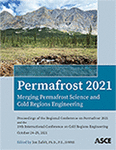Regional Conference on Permafrost 2021 and the 19th International Conference on Cold Regions Engineering
Alyeska’s 40-Plus Years of Experience with Heat Pipes on the Trans-Alaska Pipeline System
Publication: Permafrost 2021: Merging Permafrost Science and Cold Regions Engineering
ABSTRACT
Heat pipes (thermosyphons) were installed in the vertical support members (VSMs) of the Trans-Alaska Pipeline System where the pipeline is elevated in warm non-thaw-stable permafrost areas. More than 124,000 heat pipes with pure anhydrous ammonia, NH3, as the working fluid were installed during pipeline construction in the mid-1970s to thermally stabilize the permafrost surrounding the VSMs. Shortly after pipeline construction, non-condensable-gas, NCG, began to occur in some of the heat pipes, affecting their performance. Alyeska conducted an extensive research effort to identify the root cause for the occurrence of NCG and performed a test program on the degradation in heat pipe performance with the build-up of NCG. Two procedures have been used to repair underperforming heat pipes due to NCG issues: (1) Using “getter devices” and (2) recharging the heat pipes with carbon dioxide, CO2. Using getter devices was not a permanent solution to the NCG problem, and experience has shown CO2 recharging to be a successful repair option. This paper describes 40-plus years of heat pipe experience for an aboveground pipeline system in permafrost, several heat pipe options Alyeska considered prior to construction, and the choice and development of the heat pipes that were used on the pipeline. This paper also describes how Alyeska has managed NGC issues that developed after construction to ensure integrity of the aboveground system and the innovative use of heat pipes as thermometers to monitor end-of-thaw-season ground temperatures at the base of thermal VSMs as an additional integrity management tool.
Get full access to this article
View all available purchase options and get full access to this chapter.
REFERENCES
ASHRAE, (2017). 2017 ASHRAE Handbook of Fundamentals, American Society of Heating, Refrigerating, and Air-Conditioning Engineers, Atlanta, GA.
Babb, A. L., D. M. Chow, K. L. Garlid, R. P. Popovich, and E. M. Woodruff (1971). “The thermo tube, a natural convection heat transfer device for stabilization of arctic soil in oil producing regions”, Society of Petroleum Engineers of AIME, SPE Paper No. 3618.
Cady, E. D. (1978). “Cryo-Anchor proven performance for arctic foundation stabilization”, McDonnell Douglas Astronautics Company, MDAC Paper WD2887, Joint US-USSR Building Under Cold Climates and Permafrost, Leningrad, USSR.
Galate, J. W. (1975). “Passive refrigeration is best suited for arctic pile supports”, The Oil and Gas Journal, Nov. 24, 45-50.
Galate, J. W. (1976). “Passive refrigeration for arctic pile supports”, A.S.M.E., Journal of Engineering for Industry, Vol. 98, No. 2, 695-700.
Gaugler, R.S. (1944). “Heat transfer device”, United Sates Patent Office, Patent No. 2,350,348 (applied Dec. 21, 1942).
Grover, G.M. (1966). “Evaporation - condensation heat transfer device”, United Sates Patent Office, Patent No. 3,229,759 (applied Dec. 2, 1963).
Grover, L. W. (1975). “Cryo-Anchor – A design approach for arctic foundations”, McDonnell Douglas Astronautics Company, MDAC Paper WD2593, for presentation Oil and Gas Pipeline and Technology Exhibit and Seminar, Moscow, USSR.
Heat Pipes, Data Sheet C-2, Alyeska Pipeline Service Company, Anchorage, Alaska
Heuer, C. E. (1979). “The application of heat pipes on the Trans-Alaska pipeline”, Cold Regions Research and Engineering Laboratory, Special Report 79-26, Hanover, N.H.
Jahns, H. O, T. W. Miller, L. D. Power, R. L. Rickey, Taylor, and J. A. Wheeler. (1973). ‘’Permafrost Protection Devices for Pipelines”, Proceedings 2nd International Conference on Permafrost, Yakutsk, USSR, National Academy of Sciences Press, 673-684.
Johnson, E. R. (1983). “Performance of the Trans-Alaska oil pipeline”, Proceedings 4th International Conference on Permafrost, Fairbanks, Alaska, National Academy of Sciences Press, 109-111.
Long, E. L. (1965a). “Means of maintaining permafrost foundations”, United States Patent Office, Patent No. 3,217,791, (applied July 30, 1964).
Long, E. L. (1965b). “Long Thermal Pile” Proceedings 1st International Conference on Permafrost, Lafayette, IN, National Academy of SciencesPress, 487-491.
Miller, T.W. (1975). “Surface heat balance in simulation of permafrost behavior”, ASME Paper 75-WA/HT-86, Houston, TX.
Pearson, S. W. (1977). “Thermal performance verification of thermal vertical support members for the Trans-Alaska pipeline”, ASME Paper 77-WA/HT-34, Atlanta, GA.
Reed, R. E. (1966). “Refrigeration of a pipe pile by air circulation”, Cold Regions Research and Engineering Laboratory, Technical Report TR 156, Hanover, N.H.
Reid, R.L., J.S. Tennant and K.W. Childs (1974). “Modeling of a thermosyphon type permafrost protection device”, ASME Paper 74-HT-46, Boston, MA.
Sorensen, S., J. Smith and J. Zarling. (2003). “Thermal performance of TAPS heat pipes with non-condensable gas blockage”, Proceedings 8th International Conference on Permafrost, Zurich, Switzerland, 1097-1102.
Strandberg, J.S. (2020 ). Personal communication, Anchorage, AK.
Wheeler, J.A. (1973). “Simulation of heat transfer from a warm pipeline buried in permafrost”, AIChE 74th National Meeting, New Orleans, LA, March 11-15, 1973
Wheeler, J.A (1978). “Permafrost Thermal Design for the Trans Alaska Pipeline”, in Moving Boundary Problems, edited by D.G. Wilson and A.D. Solomon, Academic Press, New York, 267-284.
Waters, E.D., G.S. Gering, J.W. Galate, and P.H. McKinney. (1975). “Heat Pipe Radiators for the Trans Alaska Pipeline”, MDAC Paper WD2536, for presentation at 62nd Annual Technical Conference American Electroplaters’ Society Toronto, Canada.
Waters, E.D. (1974). “Heat pipes to stabilize pilings on elevated Alaska pipeline sections”, Pipeline and Gas Journal, Aug. 1974, 46-58.
Wikipedia, (2020). https://en.wikipedia.org/wiki/Heat_pipe).
Information & Authors
Information
Published In
Permafrost 2021: Merging Permafrost Science and Cold Regions Engineering
Pages: 327 - 338
Editor: Jon Zufelt, Ph.D., HDR Alaska
ISBN (Online): 978-0-7844-8358-9
Copyright
© 2021 American Society of Civil Engineers.
History
Published online: Oct 21, 2021
Published in print: Oct 21, 2021
Authors
Metrics & Citations
Metrics
Citations
Download citation
If you have the appropriate software installed, you can download article citation data to the citation manager of your choice. Simply select your manager software from the list below and click Download.
